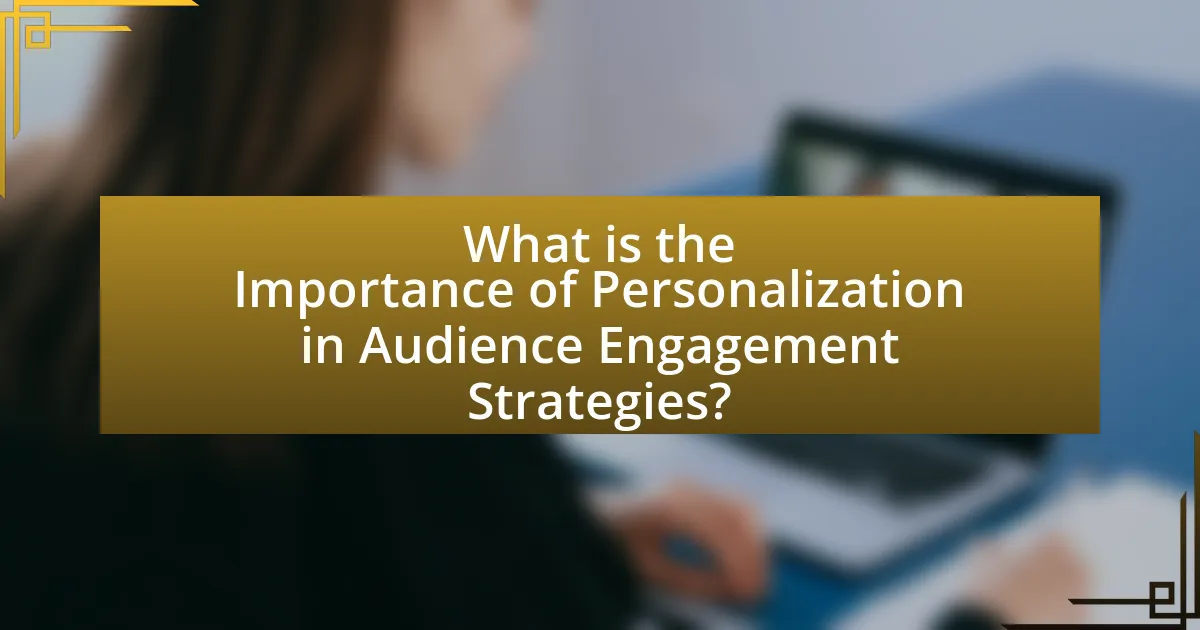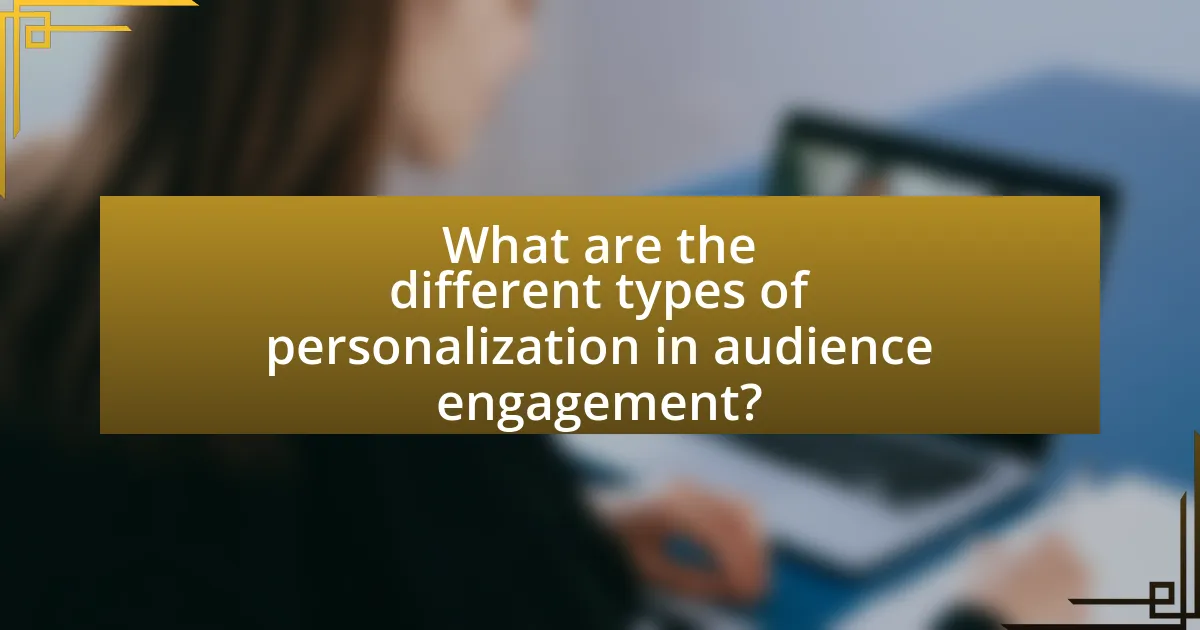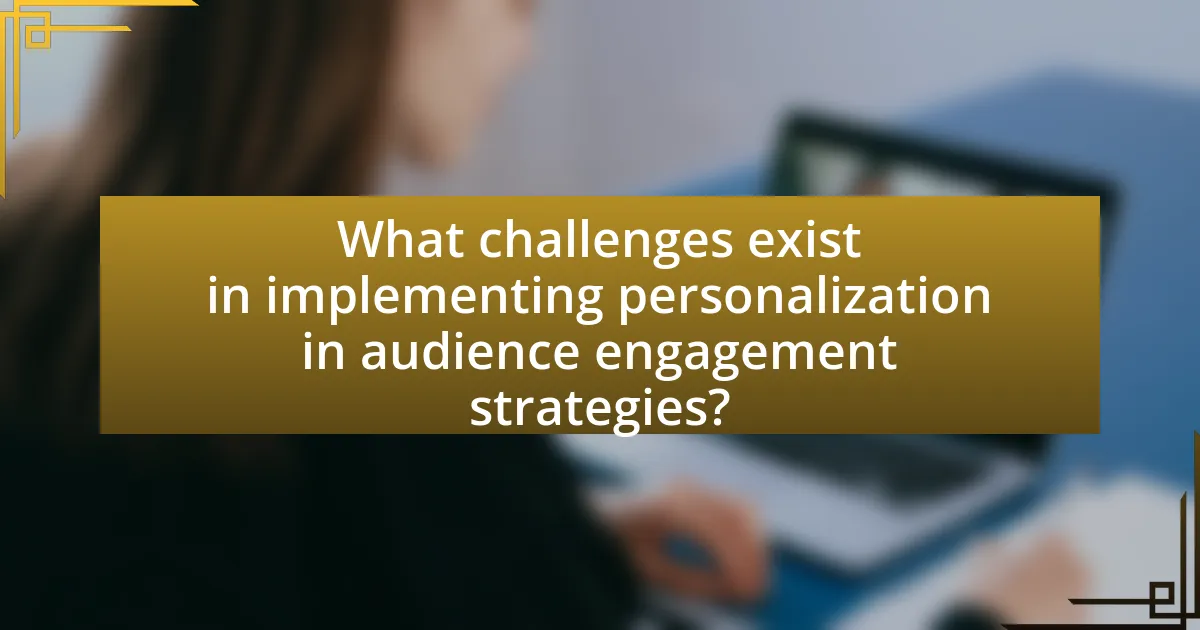The article focuses on the significance of personalization in audience engagement strategies, highlighting its role in enhancing user experience and increasing conversion rates. It discusses how tailored content and interactions based on individual preferences lead to higher engagement levels, customer loyalty, and improved sales outcomes. Key elements of effective personalization, such as data-driven insights, user segmentation, and real-time interaction, are examined, along with the impact of demographic, behavioral, and psychographic data. Additionally, the article addresses the challenges and pitfalls organizations face in implementing personalization, the technologies that facilitate these strategies, and best practices for optimizing personalized experiences.

What is the Importance of Personalization in Audience Engagement Strategies?
Personalization is crucial in audience engagement strategies because it significantly enhances user experience and increases conversion rates. Tailoring content and interactions to individual preferences leads to higher engagement levels; for instance, studies show that personalized emails can generate up to six times higher transaction rates compared to non-personalized ones. Furthermore, personalization fosters customer loyalty, as 80% of consumers are more likely to make a purchase when brands offer personalized experiences. This data underscores the effectiveness of personalization in driving engagement and achieving business objectives.
How does personalization enhance audience engagement?
Personalization enhances audience engagement by tailoring content and experiences to individual preferences and behaviors. This targeted approach increases relevance, making audiences more likely to interact with the content. For instance, research by Epsilon indicates that 80% of consumers are more likely to make a purchase when brands offer personalized experiences. By leveraging data analytics, organizations can create customized messages and recommendations, fostering a deeper connection with the audience and driving higher engagement rates.
What are the key elements of personalization in engagement strategies?
The key elements of personalization in engagement strategies include data-driven insights, tailored content, user segmentation, and real-time interaction. Data-driven insights allow organizations to understand audience preferences and behaviors, enabling them to create relevant experiences. Tailored content ensures that messaging resonates with individual users, increasing engagement rates. User segmentation involves categorizing audiences based on demographics, interests, or behaviors, which helps in delivering targeted communications. Real-time interaction facilitates immediate responses to user actions, enhancing the overall engagement experience. These elements collectively contribute to more effective and meaningful audience interactions.
How does personalization impact audience behavior and preferences?
Personalization significantly enhances audience behavior and preferences by tailoring experiences to individual needs and interests. This tailored approach increases engagement, as studies show that personalized content can lead to a 20% increase in sales and a 50% higher click-through rate compared to non-personalized content. Furthermore, personalization fosters a sense of connection and loyalty, with 80% of consumers indicating they are more likely to make a purchase when brands offer personalized experiences. This data illustrates that personalization not only influences immediate consumer actions but also shapes long-term preferences and brand loyalty.
Why is personalization crucial for modern marketing?
Personalization is crucial for modern marketing because it significantly enhances customer engagement and conversion rates. By tailoring marketing messages and experiences to individual preferences and behaviors, businesses can create more relevant interactions that resonate with consumers. Research indicates that personalized emails have a 29% higher open rate and a 41% higher click-through rate compared to non-personalized emails, demonstrating the effectiveness of this approach. Furthermore, 80% of consumers are more likely to make a purchase when brands offer personalized experiences, highlighting the direct impact of personalization on sales and customer loyalty.
What trends are driving the need for personalized engagement?
The trends driving the need for personalized engagement include the rise of data analytics, consumer expectations for tailored experiences, and advancements in technology. Data analytics enables organizations to gather and analyze customer behavior, preferences, and demographics, allowing for more targeted communication. According to a report by Epsilon, 80% of consumers are more likely to make a purchase when brands offer personalized experiences. Additionally, consumers increasingly expect brands to understand their individual needs, with 72% of them expressing frustration when their experiences are not personalized, as highlighted by a study from Salesforce. Furthermore, advancements in artificial intelligence and machine learning facilitate real-time personalization, enhancing customer interactions and satisfaction.
How does personalization affect customer loyalty and retention?
Personalization significantly enhances customer loyalty and retention by creating tailored experiences that meet individual preferences and needs. When businesses utilize data-driven insights to customize interactions, customers feel valued and understood, leading to increased satisfaction. According to a study by Epsilon, 80% of consumers are more likely to make a purchase when brands offer personalized experiences. This connection fosters emotional engagement, encouraging repeat purchases and long-term loyalty. Furthermore, personalized marketing strategies can lead to a 10-15% increase in retention rates, as highlighted in research by McKinsey, which emphasizes the importance of personalization in driving customer commitment.

What are the different types of personalization in audience engagement?
The different types of personalization in audience engagement include demographic personalization, behavioral personalization, contextual personalization, and preference-based personalization. Demographic personalization targets audiences based on characteristics such as age, gender, and location, allowing for tailored messaging that resonates with specific groups. Behavioral personalization utilizes data on user interactions, such as browsing history and purchase behavior, to create customized experiences that enhance engagement. Contextual personalization adapts content based on the user’s current situation, such as time of day or device used, ensuring relevance at the moment of engagement. Preference-based personalization relies on individual user preferences and interests, often gathered through surveys or user profiles, to deliver content that aligns with what users want to see. These methods are supported by research indicating that personalized experiences can significantly increase user engagement and satisfaction, as evidenced by studies showing that 80% of consumers are more likely to make a purchase when brands offer personalized experiences.
How can demographic data be used for personalization?
Demographic data can be used for personalization by tailoring content, products, and marketing strategies to specific audience segments based on characteristics such as age, gender, income, and location. For instance, businesses can analyze demographic trends to create targeted advertising campaigns that resonate with particular groups, leading to higher engagement rates. Research indicates that personalized marketing can increase conversion rates by up to 10% (McKinsey & Company). By leveraging demographic insights, companies can enhance user experiences and foster stronger connections with their audience.
What role does psychographic data play in audience engagement?
Psychographic data plays a crucial role in audience engagement by providing insights into the values, interests, and lifestyles of target audiences. This type of data enables marketers to tailor their messaging and content to resonate more deeply with specific segments, enhancing emotional connections and driving engagement. For instance, a study by the American Marketing Association found that personalized marketing strategies based on psychographic profiles can increase engagement rates by up to 50%. By understanding the motivations and preferences of their audience, brands can create more relevant and compelling experiences, ultimately leading to higher conversion rates and customer loyalty.
How can behavioral data enhance personalization efforts?
Behavioral data enhances personalization efforts by providing insights into individual user preferences and actions. This data allows businesses to tailor content, recommendations, and experiences to meet the specific needs of each user. For instance, a study by McKinsey & Company found that companies leveraging behavioral data for personalization can achieve a 10-30% increase in revenue. By analyzing user interactions, such as browsing history and purchase patterns, organizations can create targeted marketing strategies that resonate more effectively with their audience, ultimately leading to improved engagement and customer satisfaction.
What technologies facilitate personalization in audience engagement?
Technologies that facilitate personalization in audience engagement include artificial intelligence, machine learning, data analytics, and customer relationship management systems. Artificial intelligence enables the analysis of user behavior and preferences, allowing for tailored content delivery. Machine learning algorithms enhance this by predicting future behaviors based on past interactions, thus refining personalization strategies. Data analytics provides insights into audience demographics and engagement patterns, which inform targeted marketing efforts. Customer relationship management systems consolidate customer data, enabling businesses to create personalized experiences across various touchpoints. These technologies collectively enhance audience engagement by ensuring that content and interactions are relevant and tailored to individual preferences.
How do AI and machine learning contribute to personalized strategies?
AI and machine learning enhance personalized strategies by analyzing vast amounts of data to identify individual preferences and behaviors. These technologies utilize algorithms to segment audiences based on specific characteristics, allowing for tailored content delivery that resonates with each user. For instance, Netflix employs machine learning to recommend shows based on viewing history, resulting in a 75% increase in user engagement. This data-driven approach ensures that marketing efforts are more effective, as personalized messages lead to higher conversion rates and customer satisfaction.
What tools are available for implementing personalization?
Tools available for implementing personalization include customer relationship management (CRM) systems, marketing automation platforms, and data analytics tools. CRM systems like Salesforce enable businesses to collect and analyze customer data, allowing for tailored communication and offers. Marketing automation platforms such as HubSpot facilitate personalized email campaigns and content delivery based on user behavior. Data analytics tools, including Google Analytics, provide insights into customer preferences and engagement patterns, which can inform personalized strategies. These tools collectively enhance audience engagement by delivering relevant content and experiences to users.

What challenges exist in implementing personalization in audience engagement strategies?
Implementing personalization in audience engagement strategies faces several challenges, including data privacy concerns, technological limitations, and the complexity of audience segmentation. Data privacy concerns arise from regulations like GDPR, which restrict how organizations can collect and use personal data, potentially limiting the effectiveness of personalized strategies. Technological limitations refer to the need for advanced analytics and machine learning capabilities to process large datasets, which many organizations may lack. Additionally, the complexity of audience segmentation complicates the personalization process, as accurately identifying and targeting diverse audience segments requires significant resources and expertise. These challenges collectively hinder the successful implementation of personalized engagement strategies.
What are the common pitfalls in personalization efforts?
Common pitfalls in personalization efforts include over-reliance on data, lack of clear objectives, and neglecting user privacy. Over-reliance on data can lead to misinterpretations, as algorithms may not capture the nuances of individual preferences. A lack of clear objectives results in scattered efforts that fail to resonate with the target audience, diminishing the effectiveness of personalization. Additionally, neglecting user privacy can erode trust, as consumers are increasingly concerned about how their data is used. According to a 2021 survey by McKinsey, 71% of consumers feel that companies are not transparent about how they use their data, highlighting the importance of addressing privacy concerns in personalization strategies.
How can data privacy concerns impact personalization strategies?
Data privacy concerns can significantly hinder personalization strategies by limiting the data available for tailoring experiences to individual users. When consumers are apprehensive about how their personal information is collected, stored, and used, they may opt out of data-sharing practices or use privacy settings that restrict data access. For instance, a survey by Pew Research Center found that 79% of Americans are concerned about how their data is being used by companies, which directly affects businesses’ ability to gather insights for effective personalization. Consequently, companies may face challenges in delivering relevant content, recommendations, and targeted marketing, ultimately reducing engagement and customer satisfaction.
What strategies can mitigate the risks associated with personalization?
To mitigate the risks associated with personalization, organizations can implement data anonymization techniques, ensure transparency in data usage, and establish robust consent mechanisms. Data anonymization reduces the risk of personal data exposure by removing identifiable information, thus protecting user privacy. Transparency in data usage builds trust with users, as they are informed about how their data is being utilized, which can lead to increased engagement. Additionally, robust consent mechanisms ensure that users have control over their data, allowing them to opt-in or opt-out of personalization features, thereby reducing the likelihood of backlash against perceived invasions of privacy. These strategies collectively enhance user trust and compliance with regulations, such as the General Data Protection Regulation (GDPR), which mandates strict data protection measures.
How can organizations measure the effectiveness of personalization?
Organizations can measure the effectiveness of personalization through key performance indicators (KPIs) such as conversion rates, customer engagement metrics, and customer satisfaction scores. By analyzing conversion rates, organizations can determine how personalized experiences influence purchasing behavior; for instance, a study by McKinsey found that personalized recommendations can increase conversion rates by up to 10%. Customer engagement metrics, including click-through rates and time spent on site, provide insights into how well personalized content resonates with users. Additionally, customer satisfaction scores, often gathered through surveys, can reveal how personalization impacts overall customer experience, with research indicating that 80% of consumers are more likely to make a purchase when brands offer personalized experiences.
What metrics are essential for evaluating personalized engagement strategies?
Essential metrics for evaluating personalized engagement strategies include customer retention rate, conversion rate, engagement rate, and customer lifetime value. Customer retention rate measures the percentage of customers who continue to engage with a brand over time, indicating the effectiveness of personalization in fostering loyalty. Conversion rate assesses the percentage of users who take a desired action, such as making a purchase, reflecting how well personalized content drives actions. Engagement rate quantifies interactions with personalized content, such as clicks, shares, and comments, providing insight into the relevance and appeal of the personalization efforts. Customer lifetime value estimates the total revenue a business can expect from a customer throughout their relationship, highlighting the long-term impact of personalized engagement on profitability. These metrics collectively provide a comprehensive view of the effectiveness of personalized engagement strategies.
How can feedback loops improve personalization efforts?
Feedback loops enhance personalization efforts by continuously collecting and analyzing user data to refine and tailor experiences. This iterative process allows businesses to adjust their strategies based on real-time user interactions and preferences, leading to more relevant content and recommendations. For instance, a study by McKinsey & Company found that companies utilizing feedback loops in their personalization strategies can achieve a 10-30% increase in customer engagement and satisfaction. By leveraging insights gained from user feedback, organizations can create a more dynamic and responsive personalization approach, ultimately driving better audience engagement.
What best practices should be followed for effective personalization?
Effective personalization requires collecting and analyzing customer data to tailor experiences. Businesses should implement strategies such as segmenting audiences based on behavior and preferences, utilizing dynamic content that adapts to individual user interactions, and maintaining consistent communication across channels. Research indicates that personalized marketing can lead to a 20% increase in sales (McKinsey & Company). Additionally, leveraging AI and machine learning can enhance personalization efforts by predicting customer needs and preferences, thereby improving engagement and satisfaction.
How can organizations create a seamless personalized experience for their audience?
Organizations can create a seamless personalized experience for their audience by leveraging data analytics to understand individual preferences and behaviors. By collecting and analyzing data from various touchpoints, such as website interactions, purchase history, and social media engagement, organizations can tailor their content, products, and services to meet the specific needs of each audience member. For instance, a study by Epsilon found that 80% of consumers are more likely to make a purchase when brands offer personalized experiences. This demonstrates that effective personalization not only enhances user satisfaction but also drives sales and loyalty.
What role does continuous testing play in optimizing personalization strategies?
Continuous testing is essential for optimizing personalization strategies as it allows organizations to iteratively assess and refine their approaches based on real-time data and user feedback. By implementing continuous testing, businesses can identify which personalized elements resonate most with their audience, leading to improved engagement and conversion rates. For instance, a study by McKinsey found that companies that effectively use data-driven personalization can increase their marketing ROI by 15-20%. This evidence underscores the critical role of continuous testing in ensuring that personalization strategies are not only relevant but also effective in meeting the evolving preferences of consumers.

Leave a Reply